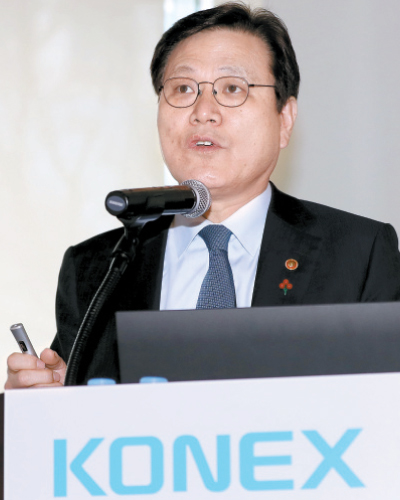Konex rules are adjusted to build demand, volume

Choi Jong-ku
On Wednesday, the Financial Services Commission (FSC) said it will allow companies on Konex to secure investments through crowdfunding for their first three years on the market. It also said it would reduce the minimum deposits individuals need to qualify for trading.
Konex was formed in 2013 to connect small- and medium-sized companies and start-ups with capital.
With the changes announced Wednesday, investors will only need 30 million won ($26,800) to trade, down from the previous 100 million won. It was reduced from 300 million won in 2015.
“Although the Konex market by volume has been growing, there have been comments that innovative companies were facing problems in securing the necessary funding due to the lack of transactions and that there were issues with payback periods,” FSC Chairman Choi Jong-ku said. “We have introduced the measures to recover the identity of Konex as a stepping stone for venture companies to grow.”
Other reforms are also being made. External audit requirements have been eased, while the process of upgrading to a higher market is being sped up.
While the market is being supported with rule changes, investor protection is being strengthened. The financial authority is increasing the number of information categories requiring public disclosure to 35 from 29.
Securities firms that trade shares in insolvent companies will be suspended for one year, up from the current six months.
When the Konex opened on July 1, 2013, 21 companies were listed on the market and the total capitalization was 468.9 billion won. As of the end of last year, 153 companies were trading and the market capitalization was 6.25 trillion won.
Since the Konex was launched, 44 Konex companies have moved to the larger Kosdaq.
The market was created to serve as a platform to help businesses that are too small to be listed on the secondary Kosdaq market and heavily dependent on bank loans for funding.
Under Konex listing requirements, companies must meet one of three conditions - annual revenue of over 1 billion won, equity capital of over 500 million won or net profit of over 300 million won. For venture companies, the bar is lower: 500 million won in revenue, 300 million won in equity capital and 200 million won in net profit.
In recent years, Konex hasn’t been able to generate much interest. The number of companies newly listed has been falling each year since peaking at 50 in 2016. In 2017, 29 companies were listed, and last year there were only 21.
While companies hope to quickly upgrade to the Kosdaq, it has taken two years to make that leap on average. For investors, the market hasn’t been appealing due to its low volume.
BY LEE HO-JEONG [lee.hojeong@joongang.co.kr]










with the Korea JoongAng Daily
To write comments, please log in to one of the accounts.
Standards Board Policy (0/250자)